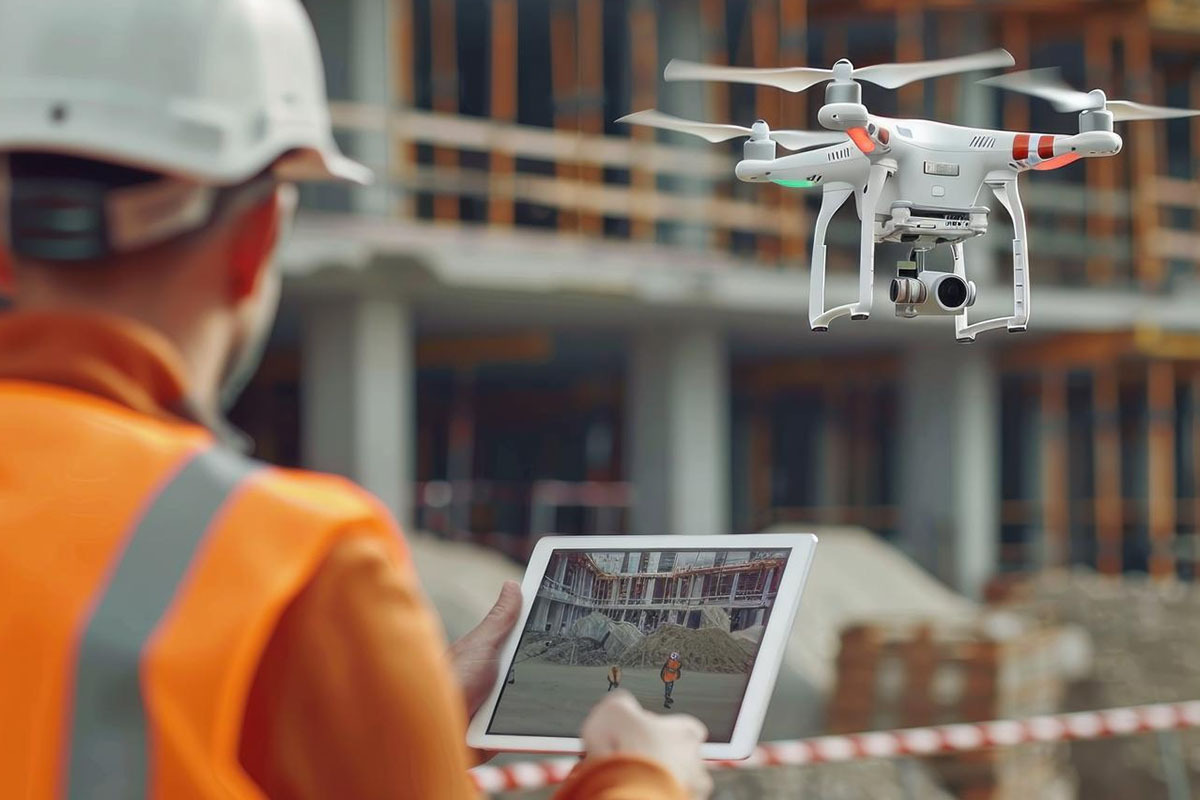
How Construction Firms Can Manage IoT, Drones and Job Site Data Effectively
Modern technology is designed as a solution to many of the common problems businesses face. Integrating products, such as the Internet of Things (IoT), drones and big data, can go a long way towards enhancing tasks and providing growth opportunities.
Historically, the construction industry has been resistant to adapting to digital initiatives due to factors such as expensive upfront costs, working around the legacy systems involved, the fragmented, siloed nature of involved parties, the necessity for extra training, complex contract structures and concerns regarding the uncertainties of a positive ROI. Perceived risks often delay or dismiss the opportunity to integrate new products.
Technology offers opportunities to all industries, but the construction industry finds itself in a unique position to leverage the latest innovations should it choose to invest. For example, IoT devices, drones and job site data can help boost productivity, improve efficiency, bolster safety initiatives and enhance decision-making.
In this article, we’ll look at the common challenges businesses face, the benefits of proper management of these technologies and practical solutions, along with future trends.
Challenges in managing data, drones and IoT
While new tech empowers construction companies to improve operations, boost safety and perform larger and more complex operations (e.g., extensive mapping projects), it can be difficult to install replacements or manage upgrades. The construction industry faces many barriers when it comes to adapting to and managing technologies, such as IoT, drones and data.
Data
Investing in new ways to manage data often involves common problems such as upfront costs, navigating around legacy systems, dealing with user resistance and training and a lack of standardization.
Drones
Drones in construction can aid in detecting problem areas more rapidly, help with mapping and provide data. Stakeholders can analyze and leverage the information drones can provide to assist them with building projects more efficiently, cost-effectively and safely. Challenges in adapting drones include expensive start-up costs, gaps in resources and knowledge, adhering to government regulations and uncertainty about ROI.
IoT
The concept of IoT has been around for a long while, but has really taken off in recent decades. Despite its exponential growth, the increased use of IoT for construction has been challenging for the industry. High initial costs, security of data, interoperability and complexities associated with integration with legacy systems have been the primary barriers. This, combined with the hurdles of reliable connectivity at remote or developing worksites, has created hesitance in investing in construction IoT management.
Even once technologies such as big data, drones and IoT are integrated, construction companies might still face challenges in management. Problems such as data overload, connectivity, integration and security must be addressed. The good news is, working with a trusted partner who has the expertise and equipment needed to successfully leverage these technologies can be a viable solution.
IIoT for Construction
The Industrial Internet of Things (IIOT) is the integration of an array of items that connect, including devices, sensors and software systems in industrial applications. Much like conventional IoT, IIoT is slightly different because it is used in specific industrial instances, rather than a combination of items used in everyday life.
- Offers real-time accident notifications
- Predicts potential failures or problems (e.g., equipment or machinery components)
- Provides strong data analysis capabilities
- Assists in risk management with real-time visibility
Other ways it differs are that it handles high volumes of data from many connected sensors and machines at construction sites. Essentially, it operates similarly, but is a more advanced version of IoT.
Benefits of effective data management

Ways to perform effective data management include installing centralized platforms, real-time analytics and secure cloud storage. Once these are established and challenges are effectively identified and resolved, construction firms often find they reap numerous benefits once they update and make technology investments.
Centralized data platforms
The construction industry typically has many different stakeholders with numerous moving parts. As a result, your projects likely become siloed, making it difficult for all involved to have access to current, real-time data. This can lead to delays and rework in your projects. Having a centralized data platform can easily resolve all those problems.
Real-time monitoring & analytics
Construction projects, regardless of size, involve numerous decision-making points throughout the process. Investing in data software can empower construction companies to enjoy real-time monitoring and access to high-level analytics, making it easier to make on-the-fly decisions or to take the time to evaluate any data accrued and use it to make better decisions.
IoT allows for smart construction, including tracking assets, environmental monitoring, sensors for concrete pouring and scaffold monitoring. Drones can assist in providing real-time footage to help with the inspection process and provide viewpoints for not easily accessible areas.
Cybersecurity measures
Not unlike any other industry, construction data security is vital. Construction companies run the risk of a cyberattack, and even one incident can compromise sensitive data, disrupt operations, disrupt connectivity and create massive financial losses. When technologies, such as Building Information Modeling, IoT sensors, drones and other data-based tech are utilized, they run the risk of a cyberattack or other types of sabotage.
The good news is, while tech can increase risks, it can also significantly reduce risks, mitigate attacks and safeguard digital assets. With the right tools, cyberattacks can be prevented, allowing construction companies to enjoy consistent connectivity, effectively manage material flows and easily coordinate with other stakeholders. Worksites can also be better secured with remote management and monitoring, assets can be better tracked and issues that typically cause downtime can be eliminated.
Integration with project management tools
While information previously tended to be decentralized, modern tools quickly resolve those barriers. Integrating new tech with project management tools creates a centralization point, enabling businesses to create unified workflows, boost automated capabilities, reduce errors, better data accuracy and streamline collaboration and communications between stakeholders.
Regulatory compliance considerations
With so many regulatory compliance requirements in the construction industry relating to areas such as safety, environmental and privacy, companies need to ensure they adhere to rules to avoid fines and penalties.
Drones and IoT can help bolster compliance by providing automation, giving real-time data and creating audit trails. Companies can leverage tech to ensure they are abiding by requirements set by OSHA and the EPA. However, the use of some tech, such as drones, does introduce new requirements, such as those set forth by the FAA.
Best practices
Investing in any new technology should be done carefully and thoughtfully. Steps your company’s decision makers should take include:
- Identifying your business’s pain points
- Evaluate your company’s future goals and objectives
- Assess business needs as they relate to understanding workflows
- Get stakeholder feedback to ensure no important factors are inadvertently overlooked
- Examine potential solutions to mitigate pain points
- Prioritize the right technologies
- Vet products and vendors
- Create a change management plan (e.g., implementation, user training, responsibilities, etc.)
- Establish a tech integration calendar
After installation, it’s important to consistently monitor and analyze routinely to ensure all operates as intended and adjust as necessary.
Future trends in connected construction
Connected construction is the future, and businesses that continue to avoid investing in smart job site technology may find themselves lagging behind their competition in the industry. If your company is considering investing in updating its technical capabilities, the following trends are ones to examine as potential investments.
Artificial intelligence
Artificial intelligence is already being leveraged in numerous ways in the construction industry, and, going forward, AI will play an even more prominent role in how it can transform how a firm operates and provide actionable insights.
- AI-driven predictive maintenance
- Machine learning algorithms
- Process massive amounts of data
- Predictive data to analyze and identify patterns
- AI-equipped drones to scan structures and worksites
These and other AI-based functions can help with making data-driven decisions, forecasting staffing, performing design and risk management, identifying safety issues, recognizing material shortages, detecting budget overruns, or even spotting weather issues.
The bottom line is, decision-makers can use the information AI assembles and use it to avoid potential problems.
Drones and robotic initiatives

Drones can be used for surveillance, inspections and monitoring of worksites. Just a mere five years ago, there was a staggering 239% increase in drone use, much of which is attributed to the construction industry. Robotics is likely to also become more commonplace in construction projects as they can perform tasks and eliminate safety hazards for workers – all of which can improve productivity and, ultimately, profitability.
While upfront costs may seem like a lot, construction companies are finding that drones and robotics are substantially decreasing costs over the long term. They are cost-effective because they save companies money on expenses such as land surveying, topographical planning and security systems. Due to their efficiency, delays are less common, projects can be monitored remotely and 3D videos and images can be quickly obtained.
Internet of Things
IoT has successfully transformed construction sites into their own connected ecosystems because of the array of sensors and devices used. With people (e.g., wearable tech), drones, tools, machines and other equipment centrally linked through IoT, real-time data is accessible to help planners, workers and other stakeholders improve, remedy or plan.
Technology Gives Construction Firms a Competitive Advantage
As one of the largest industries, construction firms have a lot of moving parts and numerous stakeholders involved in every project. Whether commercial or residential, any project could be enhanced using data analysis, drones and IoT.
Challenges associated with the integration of technology may deter some companies from migrating to IoT, drones and other data-driven systems. However, even businesses without robust systems can enjoy the benefits without the steep costs. Working with a managed services IT provider can help you remain on budget but gain access to the tools your construction company needs.
Ready to Transform Your Construction Firm’s Capabilities? Red River Can Help Get You on Board!
The Internet of Things has steadily ingratiated itself into all aspects of life, and the construction industry is not an exception. Sensors and other devices, coupled with drones and data-driven systems, can transform your business and make it more productive and efficient while keeping down costs.
While it’s true there will be an initial investment, over time, the long-term cost-benefits will become clear. Aside from the tangible cost savings associated with real-time data and remote monitoring, you can make your company safer, compliant and on budget, along with an improved security posture.
The professional team at Red River is equipped to offer your construction business its expertise, experience, knowledge and technical skills. Whether you already have an in-house IT department or lack the ability to maintain one, we can help fill any gaps your firm faces.
We consistently invest in learning the latest cutting-edge solutions so we can share them with our clients. Should you select Red River to be your trusted partner, you can rest assured that we will help bring your firm to a higher level of competitiveness while streamlining your processes to bring down costs.
Ready to explore your options? Contact Red River today to schedule a consultation.

written by
Corrin Jones
Corrin Jones is the Director of Digital Demand Generation. With over ten years of experience, she specializes in creating content and executing campaigns to drive growth and revenue. Connect with Corrin on LinkedIn.




